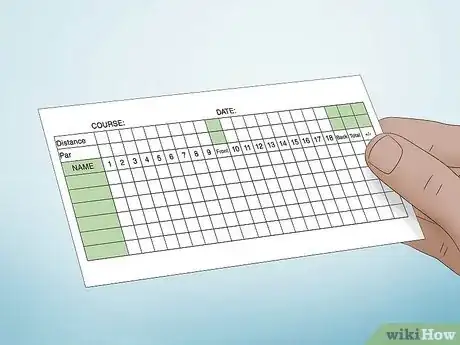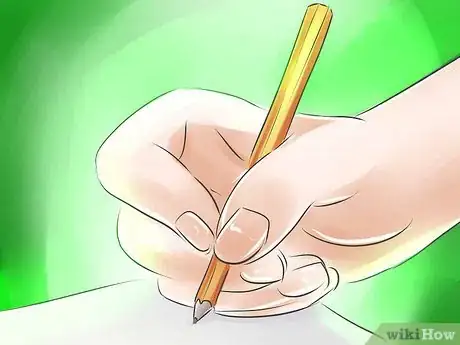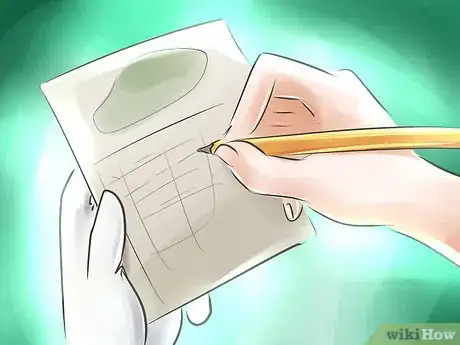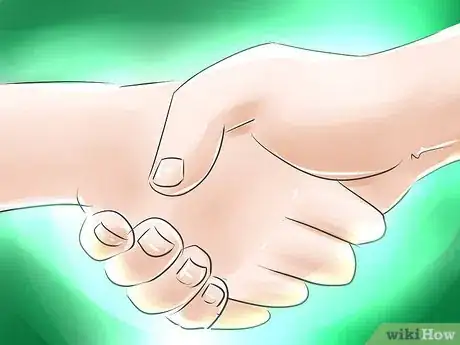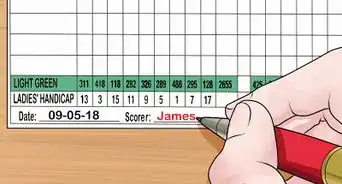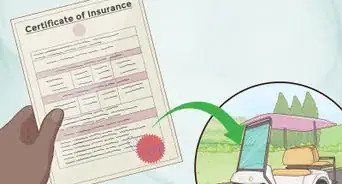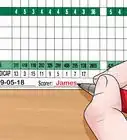wikiHow is a “wiki,” similar to Wikipedia, which means that many of our articles are co-written by multiple authors. To create this article, 12 people, some anonymous, worked to edit and improve it over time.
There are 14 references cited in this article, which can be found at the bottom of the page.
wikiHow marks an article as reader-approved once it receives enough positive feedback. This article received 11 testimonials and 90% of readers who voted found it helpful, earning it our reader-approved status.
This article has been viewed 353,007 times.
Learn more...
Fore! Unlike the scoring system of most sports, in golf, less is actually more. A score of 72 is way better than a score of 102. Keeping score in golf may seem simple -- hit the ball, find it, hit it again, and so on -- and add up all shots at the end. However, there are a few subtleties that you should know before you start playing golf and keeping score correctly. See Step 1 to get started.
Steps
Keeping Score in Stroke Play
-
1Get a scorecard. A round of golf is played over 18 holes.[1] After each hole, you should record your score on a scorecard. Even experienced golfers can miss a shot here or there without a scorecard. Keep track of your score and the scores of the other players in your group.[2]
- Typically, you are responsible for keeping the score of your opponent, and your opponent is responsible for keeping track of yours. After every round, you have to look over your opponent's card, agree that he has written down your score correctly, and sign or initial it. You'll also have to do this at the very end of the round. So if your opponent makes a mistake (even assuming it's an honest one) that somehow makes your score even worse than it should be, you have to take the blame for it.
- Other players designate one person to be in charge of keeping score for all of the players before the game begins.
-
2Count every purposeful attempt to strike a ball as a stroke. It's likely that 99.9% of the time a golfer will make contact with the ball. But if he/she tries to hit the ball and whiffs, it still counts as a shot. On the other hand, if you take a practice swing and accidentally hit the ball, it doesn't count. Every time you take a swing at the ball, therefore, it counts as a stroke, whether anything good happens or not.[3]
- Each hole will have a number of strokes listed under "Par".[4] This is the average amount of strokes it should take to get the ball in the hole. If the par is 3 and you make a 4, then your score can be viewed as 1-over. If the par for the course is 80 and you finished the course with a 95, then your score is 15-over.
- Though you don't have to know them to keep score, you should know that a birdie is one stroke under par, an eagle is two under par, and a bogey is one over par.
- Some players decide that they can take no more strokes for each hole than a double bogey, or 2 points over par.[5]
Advertisement -
3Know your penalties. Penalties are shots that cost you extra points. Remember that you want your score to be as low as possible, and the penalties drive them up. Here are some penalties:[6]
- If you hit a ball in the water, drop a new ball in the designated location and take a 1-stroke penalty.
- If you hit the ball out of bounds (as indicated by white stakes), re-hit from the original location and take a 2-stroke penalty.
- If you lose a ball, re-hit from the original location and take a 2-stroke penalty.
-
4Add up your points. When you're finished, add up your scores from each hole for a cumulative total. Double check it. If you're playing in a tournament, one of your competitors will be keeping your official score. You must check it and then sign your scorecard to make it official. The player with the least amount of points wins the game.[7]
- Some players add up the points every 9 holes so that they don't have to do too many calculations at the end and can settle disputes over the score more easily.
-
5Know your handicap. Once you've played at least ten rounds of golf on the same course (or however many rounds you have to play for the course to determine your handicap), you'll have a handicap. A handicap takes into account your previous scores throughout the same previous round of golf, and you can play the game while keeping your handicap in mind. (The goal is to do better than you previously did.)[8]
- If you want to get fancy with the handicap, then you can play using the Stableford method. In this scoring method, your golf score is made not of a number of strokes you get per hole, but a number of net points you get per hole. If your net score is equal to the par, you get 2 points; if you hit one over par (a bogey), you get 1 point. If you get 1 under par (a birdie), you get 3 points, and if you hit 2 under par (an eagle), you get 4 points. The player with the most points wins.[9]
Keeping Score in Match Play
-
1Score each hole as "holes up" or "holes down."[10] This is a great way to play for beginners, and you don't have to be as meticulous about keeping track of exactly what happened in every single round. All you have to do is win more holes than your opponent. So, let's say that your score on the first hole was 5 and your opponent's score on the first hole was three; your opponent is now "one up" because your opponent is one hole ahead of you.[11]
-
2Concede a hole if necessary. If you're having an impossible time getting the ball into a hole during a certain round and would rather save your energy and sanity, then you can give up that hole and move on to the next. You get a clean start in the next hole.[12]
-
3Keep track of who has won each hole. Continue to play and write down who has won each hole after every round. Just write +1 if you're up a hole for a certain round or -1 if you're down for that round. If you and your opponent got the ball in the hole with the same amount of strokes, you can write "AS" under the hole and consider it a draw.
-
4End the game when one player is more holes up than there are holes remaining. Matches can be one by scores of "four and three."[13] This means that one player will win after being four holes ahead with only three holes remaining (after the 15th hole) since the other player will not have the opportunity to win back enough holes to win the round.
-
5Don't obsess over how many shots you're taking. If you're a beginner, it's more important to focus on getting the ball in the hole than being upset about taking too many shots. This way, you'll be more focused on falling into a rhythm than overanalyzing your game. As you become more advanced, you can work on marking down every one of your shots and making room for improvement.[14]
Community Q&A
-
QuestionWhat does an X signify when it is entered with a hole's score?
 Community AnswerWhen you see an X on the card, that means that the player didn’t return a score on the hole.
Community AnswerWhen you see an X on the card, that means that the player didn’t return a score on the hole. -
QuestionWhat is the maximum possible score on any given hole?
 Community AnswerRules of golf don't limit the number of strokes a player may take on any hole. If it requires seventeen strokes to hole out (including penalty strokes) then your score for that hole is 17. It can be more.
Community AnswerRules of golf don't limit the number of strokes a player may take on any hole. If it requires seventeen strokes to hole out (including penalty strokes) then your score for that hole is 17. It can be more. -
QuestionHow are ties broken in tournament play?
 Community AnswerIt depends on the form of play. In match play, ties are broken by sudden-death. In stroke play, a playoff is held over a certain number of holes, whether it’s 18, nine or just a few.
Community AnswerIt depends on the form of play. In match play, ties are broken by sudden-death. In stroke play, a playoff is held over a certain number of holes, whether it’s 18, nine or just a few.
Warnings
- If drinking beers is part of your round of golf, forget keeping score and focus on keeping your golf cart on the cart path.⧼thumbs_response⧽
- If you get stuck playing with someone who always tries to give him/herself a lower score, don't argue. Especially if it's a spouse/boyfriend/girlfriend. Find someone else to play with.⧼thumbs_response⧽
- If you sign for a wrong score in a tournament, you'll be disqualified.⧼thumbs_response⧽
References
- ↑ http://www.scottishgolfhistory.org/origin-of-golf-terms/18-hole-round/
- ↑ https://howshegolfs.com/basics/keeping-score-in-golf
- ↑ https://www.liveabout.com/how-to-mark-a-golf-scorecard-1562687
- ↑ https://www.liveabout.com/par-3-to-5-yardage-guidelines-1564466
- ↑ http://www.golflink.com/how_44_keep-score-golf.html
- ↑ https://www.dummies.com/sports/golf/how-to-score-golf-penalty-shots/
- ↑ https://howshegolfs.com/basics/keeping-score-in-golf
- ↑ http://www.dummies.com/how-to/content/how-to-use-the-golf-handicap-system.html
- ↑ http://www.golf-basics-for-women.com/golf-score.html
- ↑ https://www.liveabout.com/how-to-make-an-up-and-down-1561028
- ↑ http://www.dummies.com/how-to/content/keeping-score-at-golf.html
- ↑ https://golftips.golfweek.com/mean-concede-hole-golf-2432.html
- ↑ http://www.leaderboard.com/GLOSSARY_SCORINGMATCHPLAY
- ↑ https://practical-golf.com/golf-tips/
- ↑ https://golftips.golfweek.com/apply-golf-handicap-score-1928.html
About This Article
To keep score in golf during stroke play, write down each player’s number of strokes at the end of each round. If a player swings at the ball, it counts as a stroke, even if they do not make contact with the ball. You should also keep track of penalties, such as a 2-stroke penalty for hitting the ball out of bounds or a 1-stroke penalty for hitting the ball into water. Add up the total scores for each hole. At the end of the game, the player with the lowest score is the winner. If you want to learn how to track scores during an official match, keep reading the article!
